(Note: If you are only interested in pictures, skip past this and hit “Continue Reading”)
This is a historical phenomenon, which entertains and fascinates me to no end. Buddhism had a huge impact on all East Asian cultures, especially on their pantheons of deities. On first glance it might seem odd that a reform movement, which rejected many of the core tenants of Vedic religion would transmit a belief in Vedic deities. This apparent oddity is a misunderstanding of Buddhism’s “atheism,” and a misunderstanding of what a “Deva” actually is. Most forms of Buddhism, while rejecting the concept of all-powerful gods or creator deities, openly accept the existence of powerful supernatural beings. This includes yakshas (nature spirits) rakshasas (demons) gandharvas (celestial musicians) nagas (supernatural snakes) and many other beings, including Devas (deities.) In Hindu and Buddhist cosmology, Devas are created beings that roam around the universe seeking the divine, albeit very powerful ones with much greater spiritual capabilities than humans. Hindu traditions tend to accord Devas much more power and divinity than Buddhism, and worship them as manifestations of The Supreme. In the Buddhist pantheon, the Devas have generally converted to Buddhism and now serve as his protectors, the protectors of his teachings, or as helpers to mortals who are trying to achieve enlightenment.
The reader should be aware that in Japanese mythology and theology the below deities freely interact with native Shinto deities, and deities imported from China. I am isolating the Indian derived deities for the purpose of this bog post, but do not be deluded into thinking that they are unintegrated with the rest of Japanese mythology.
The more popular of these deities are used in non-esoteric Mahayana Buddhism (the bulk of Buddhist sects in Japan.) However, most of these are relatively obscure deities because they are only used in the Shingon school, an esoteric (tantric) school of Buddhism. As such, the bulk of these Devas achieved full development in Japan around the late 700s or early 800s, as a result of the rise in popularity (especially amongst the political elite) of esoteric and Shingon Buddhism.
Last note: There are a lot of different names involved here, because (among other reasons) Sanskrit and Japanese don’t transliterate very well. For deities in which two names are listed, the first is Sanskrit, and the second is Japanese. In cases where, for some reason, I’ve listed many names, I will specify with an (S) or a (J) which language it is from.
(S) Ganesha/ (S) Vinayaka / (J) Binayaka / (J) Shoten/ (J) Kangiten: Ganesha was one of the first Indian deities to transit to Japan, and as in India, is one of the most popular in both esoteric and non-esoteric sects. Perhaps this is because his association with worldly prosperity has been retained, or perhaps amplified into a general association with pleasure. Thus, actors, geishas, gamblers, restaurant proprietors, etc offer him worship. Shoten has retained the association for removing obstacles, although his ancient association with creating obstacles which has long since been expunged from the Hindu tradition is still mildly active in Japan for reasons which will become clear later.
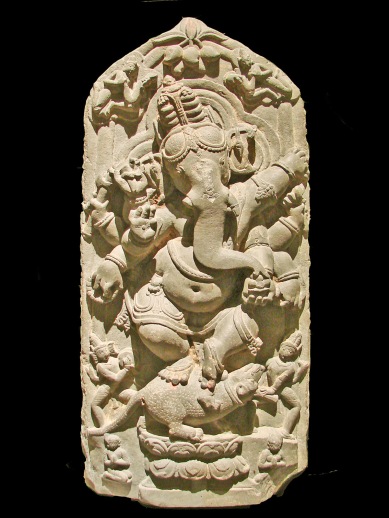
Dancing Ganesha from North Bengal, 11th Century. Image From Vikram Kharvi’s blog “My Lord Ganesha”
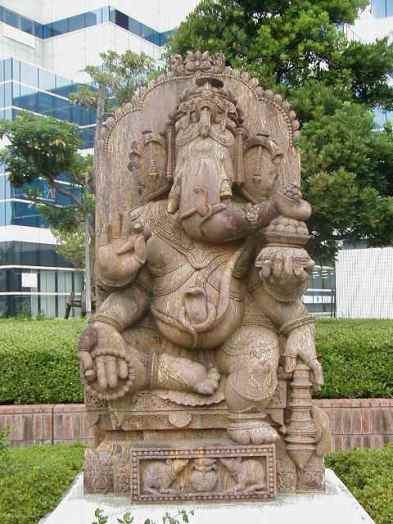
Contemporary Kankiten Statue from Fukuoka Japan. Image from this Japanese Website
He is often depicted in (implicitly erotic) embrace with another elephant headed figure. In that iconography, his name is “Kangiten” or “Binayaka.” This is an allusion to a Japanese myth about Kangiten’s “evil” origins, wherein his mother, Uma births 1,500 evil children onto her left (collectively called Binayakas), the first of which was Binayaka. On her right side she births 1,500 good children the first of which was Avalokiteśvara/Kannon (the Bodhisatva of compassion) incarnated as Idaten (Skanda or Murugan in India.) In order to win Binayaka over to goodness, Idaten reincarnates as a female binayaka and becomes Kangiten’s wife. The bliss generated by their union turns Kangiten good. According to this myth therefore, the embracing Kangiten figures actually represent Kangiten in sexual union with his brother reincarnated as his wife/sister. There are other myths, which seek to explain this iconography, but all of them involve some sort of gender reversal, usually by means of reincarnation.[1] There is a huge corpus of Japanese Ganesha myths, which do not exist at all in India, but the initial one just mentioned seems to almost reference Ganesha’s actual historical development in India. Ganesha probably evolved from the set of demons called Vinayakas/Binayakas who were known for erecting obstacles and creating divisions between allies. However, they were easily appeased. So easily appeased in fact that over time they evolved into positive forces, and merged into one deity—Ganesha.[2]
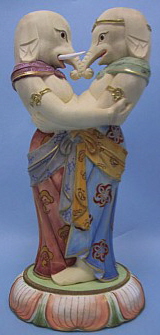
Embracing Kangiten. Image from onmarkproductions.com
However, the aforementioned Japanese myths all seem to be trying to explain the dual figured Kangiten iconography by posing, as it’s mythological basis. The real basis lies elsewhere, probably in the translations of Amoghavajra, a half Indian half Sogdian monk living in China in the early 700s. He was a founder of the “Chen-Yen” school of esoteric Buddhism (a precursor to the Shingon school,) and his translations of various tantric texts entail repeated references to the “dual-bodied Vinayaka” which is an obstacle removing and prosperity inducing deity described as looking exactly like modern embracing Kangiten figures, including the erotic embrace. There was also a pre-Buddhist Japanese deity named N-io, which took the form of a male and female in embrace, which could have contributed, or facilitated the popularity of the embracing Kangiten figures.[3]
(S) Shiva/ (S) Mahakala/ (J) Daikoku-ten: Daikoku-ten is the most popular manifestation of Shiva (also known as Mahakala), although he is also the most different from the Indian version. His traditional trishula style trident has been replaced by a magic, prosperity-producing mallet. He is one of the Seven Lucky Gods, and as such carries a sack of treasure on his shoulder symbolizing wealth, wisdom, and patience. An association with wealth has wholly supplanted his association with destruction. Daikoku-ten’s jovial appearance is a far cry from Rudra, The Howler who struck terror into the hearts of Vedic era Indians. However, According to the Chinese pilgrim I-Tsing, this shift to a softer less frightening protective deity was already well underway in Western India by the 7th century (around the time when Buddhism began gaining large numbers of Japanese adherents).[4] Daikoku-ten images are also commonly found in kitchens, a tradition possibly imported from China or India where Mahakala images were put in monastery kitchens. [5]
However, Daikoku-ten can also be manifested in 6 different forms, one of them being his consort, Kali, and another one is his son. For more details click here.
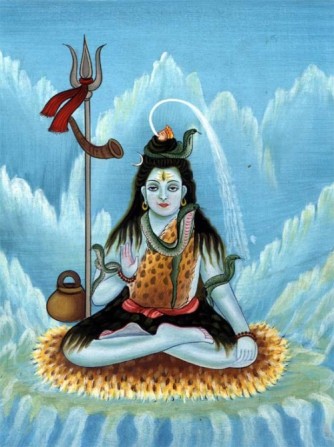
Contemporary Indian Shiva miniature. Image from Art of Legend India
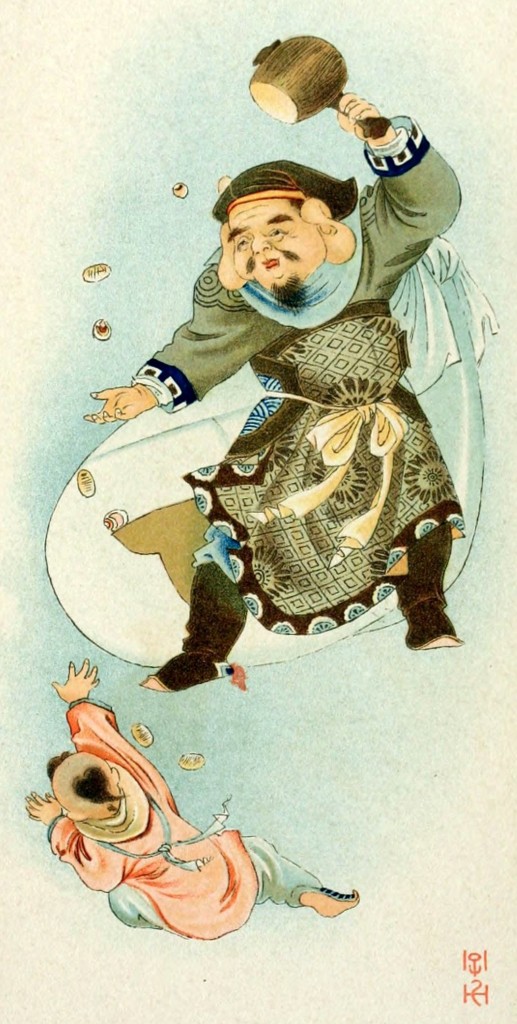
Daikokuten image published in 1902. Image from Wikipedia
Shiva/Daijizaiten: This is the form of Shiva, which more resembles the Indian version. Daijizaiten is a protective deity, and takes on Shiva’s classical role as defender of the northeast. Some depictions retain the dark skin, while others do not but a fierce aspect is usually present. In Medieval times, Japan was considered the home of Shiva, and he was thought to be its cosmic ruler. He was also thought to be the creator of the Chinese writing system. [6]
Shiva can also be manifested as a part of Sanmen Daikoku, an amalgam deity consisting of Shiva (now in Daikoku form once again), Kubera, and Saraswati.
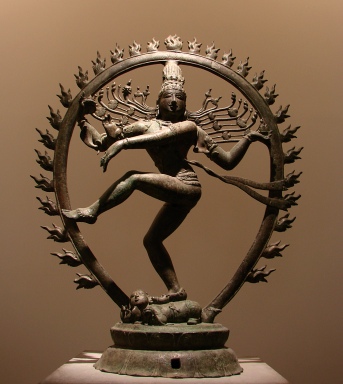
11th century Chola Dynasty (Tamil) Shiva preforming the Natraja dance (the dance which destroys the universe.) Image from Wikipedia
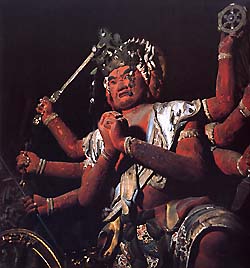
Daijizaiten, Edo Era (1603 to 1868) from Gokokuji Temple (Tokyo.) Image from Gokokuji Temple website via onmarkproductions.com
Shiva, Kubera, and Saraswati/Sanmen Daikoku: This is a three-headed deity which was invented relatively late– the late 14th century. A fierce aspect is sometimes depicted, but it doesn’t seem integral to the deity. See the following two entries for information on the Japanese forms of Kubera and Saraswati. [7]
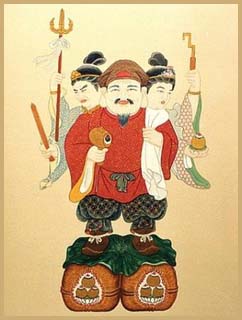
The left face is Kubera/Bishamon, the center face is Shiva/Daikoku, and the right face is Saraswati/Benzaiten. Image from the blog “Daruma Museum”
Saraswati/Benzaiten: Another one of the Seven Lucky Gods. Her stringed instrument has switched nationalities, from an Indian veena to a Japanese biwa. She has retained her association with waters, music, language and knowledge. The emphasis on physical beauty seems to have heightened in the Japanese version. Overall she seems to have been transmitted to Japan without much major change. She has become the bodhisattva of entertainers, similar to how musicians worship Saraswati in India.[8] Shinto worshippers have also adopted her as a kami. [9]
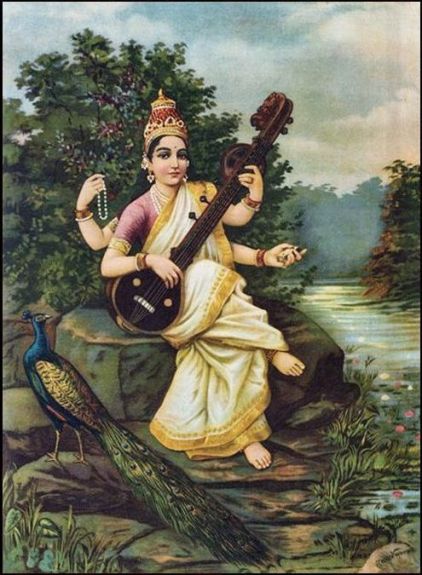
Painting of Saraswati by Raja Ravi Varma (1884-1906.) Image from Wikimedia Commons
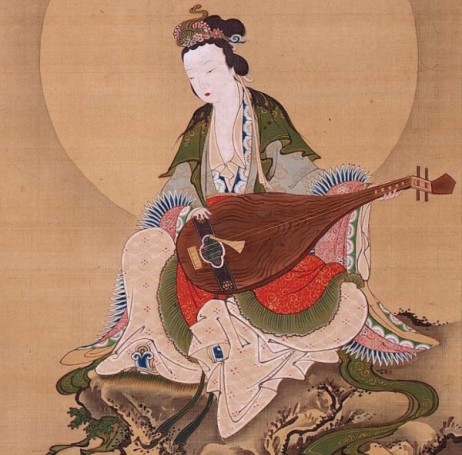
Painting of Benzaiten by Haritsu Ogawa (1663-1747.) Image from the blog Samuel Snoek-Brown
Kubera/Bishamon: In Japan Kubera does double duty as another one of the Seven Lucky Gods, and also as the Heavenly King of the North. Heavenly Kings are guardians of the cardinal directions, and Kubera is the only Hindu Deva to become one, the rest being novel Buddhist creations. In stark contrast to Kubera’s relatively mild portrayal in India and other parts of the Buddhist world, Bishamon is an enforcer of justice and a god of war. His prominence in Japan far outstrips his prominence in India. Statues of him are often used as a temple guardians, and his depictions are accordingly fearsome. It almost seems like Kubera and Shiva’s Daikoku-ten form switched roles when exported to Japan. Bishamon even holds a trident, reminiscent of Shiva. [10] [11]
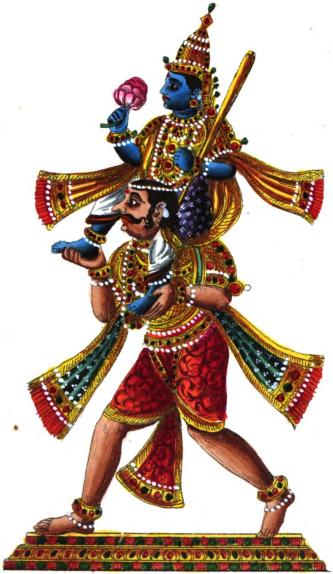
Kubera, 1842. Image from Wikimedia Commons
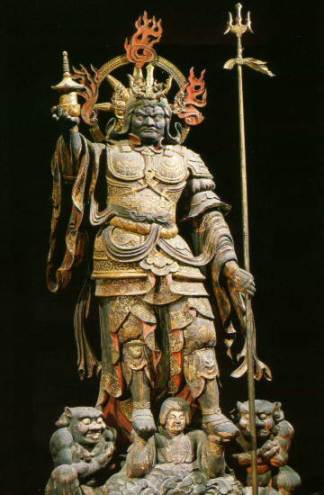
Bishamon (Tamonten), 9th century, Toji Temple (Kyoto.) Image from onmarkproductions.com
(S) Indra/ (S) Shakra / (J) Taishakuten: He not changed much from the Indian Buddhist version (which has already expunged the Hindu association with warfare.) Like Indra and Shakra, Taishakuten is the lord of storms, commands the Four Heavenly Kings, and lives atop Mt. Meru. He has even retained his elephant mount, which I imagine must have been difficult for Japanese sculptors who had never seen a photograph of an elephant. As the king of weather, he is also the commander of the Four Heavenly Kings. He also contributed to the evolution of the thunder god Raijin which will be addressed later.[12] Japanese folk tales have cited Taishakuten and his wife (Shachi) as an example of the ideal romantic couple, much like Ram and Sita are in India. [13]
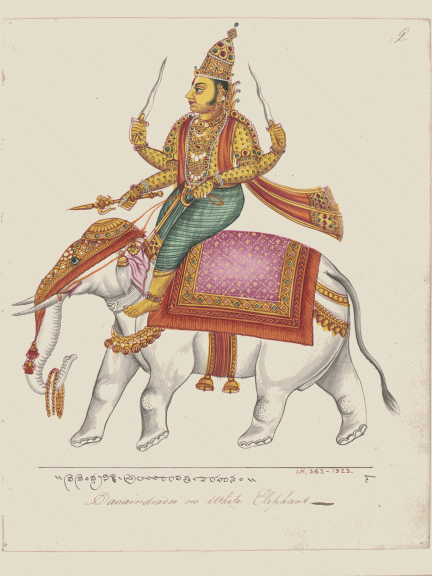
Indra, made in 1820-1825 in Tiruchchirappalli (Tamil Nadu.) Image from Wikimedia Commons
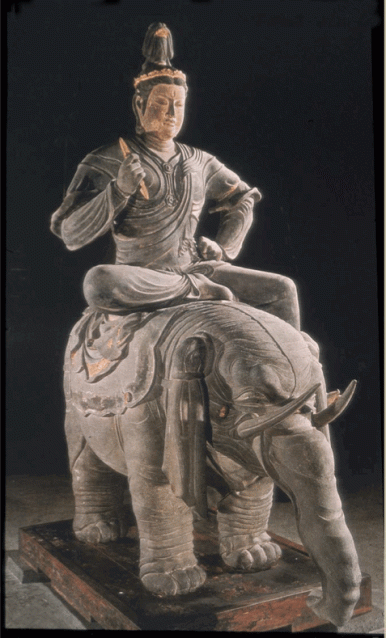
Taishakuten. Image from Ohio State University’s Huntington Archive
Yama/Enma: Yama doesn’t seem to have undergone major changes from the standard Buddhist version to his Japanese incarnation. He is still the “God of Death,” king of the underworld, and judge of the dead, and consequently has a fearsome aspect to represent death and justice. The only major difference is that he sometimes manifests as 10 different judges, one for each layer of the underworld. His Indian style crown is gone, replaced by a Japanese judge’s cap (sometimes with the word for “King” on it) and gown.[14]
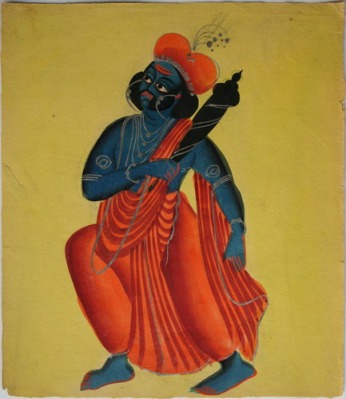
Kalighat (Bengali) painting from the late 19th century. Image from Wikimedia Commons
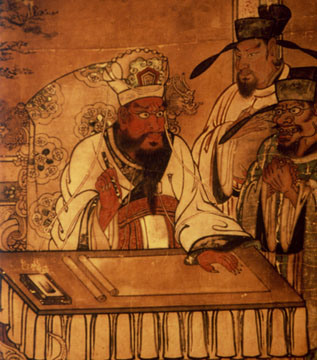
Enma as depicted in a wallscroll from the Azuchi-Momoyama period (1573 to 1603) found in Nara, Japan. Image from Wikimedia Commons
Garuda/Karura: I hesitate to include this in my list, because although Garuda is a singular personal Deva in Hinduism, in Buddhism Garudas are a race of anthropomorphic bird creatures. The Buddhist version has been transmitted to Japan almost completely intact. The association with fire seems to have been amplified to the point where the Karuras are capable of breathing fire.[15] A notable difference between the two versions is that in Japan Karuras are sometimes depicted playing the flute. [16]
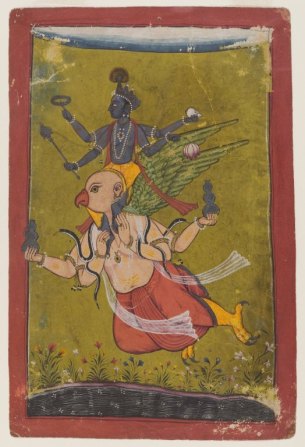
Garuda serving as Vishnu’s mount. Created between 1723 and 1727. Image from Wikimedia Commons
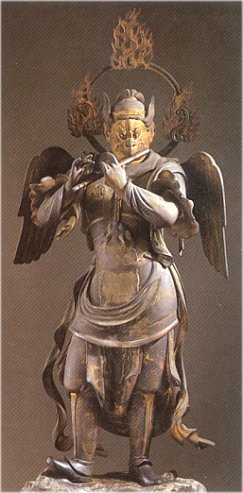
Karura, from Sanjūsangendō (a temple in Kyoto)
Kamakura Era (1185–1333.) Image from onmarkproductions.com
Brahma/Bonten: Bonten remains relatively unchanged from Buddhist Brahma. However, Buddhism in its rejection of a divine creator strips the Hindu Brahma of his universe-creating abilities and transforms him to the “king of the Realm of Forms.” It is said that Brahma descended from Heaven to teach the Buddha’s teachings to humans and bring them to enlightenment.[17] In medieval Japan, Brahma was thought to rule over India (as Vishnu ruled China and Shiva ruled Japan) and created it’s brahma writing system. Joto’s “Commentary on the Treatise on the Lotus Sutra” contains an interesting variation of the Hindu myth of the creation of the Vedas. In both versions the four faces of Brahma expound the four Vedas, but in Joto’s version there is a fifth face atop Bahma’s head which preaches a fifth Veda. The fifth however is the most profound and difficult to understand, and it is not circulating in our world.[18]
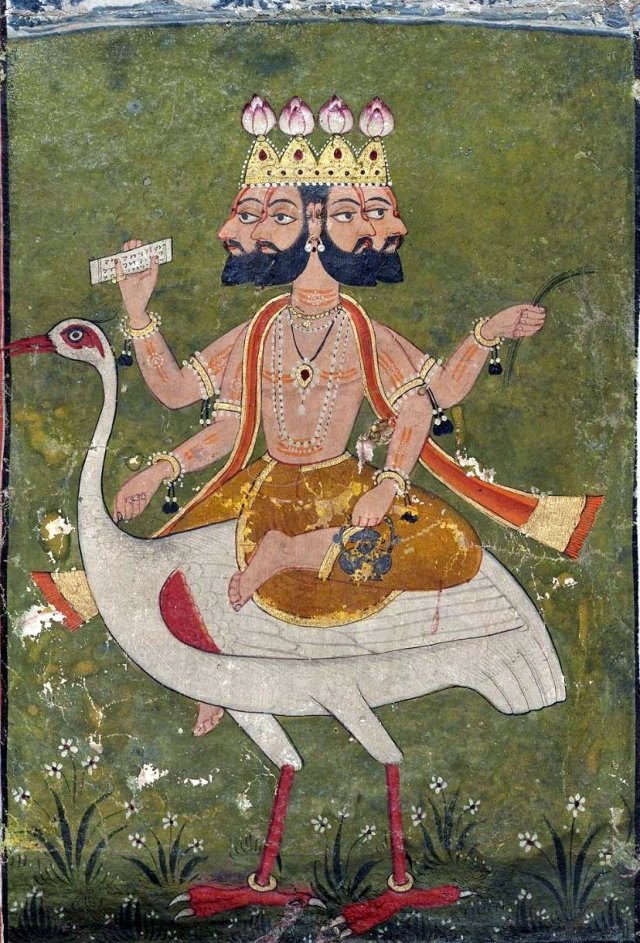
Brahma. Punjabi depiction from about 1700. Image from Wikipedia
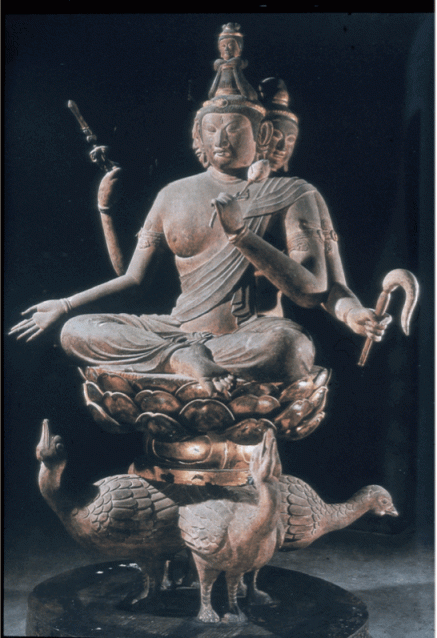
Bonten. Image from Ohio State University’s Huntington Archive
Prithvi/Jiten: Guardian of the downward direction. Earth goddess. Consort of Brahma/Bonten. Unchanged.
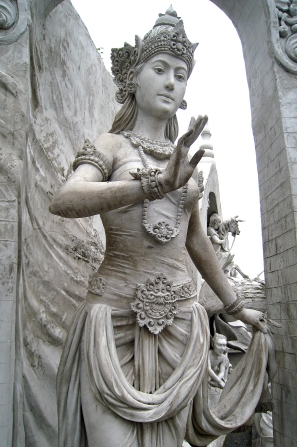
Contemporary Prithvi statue from Jakarta Indonesia. Prithvi worship fell out of fashion quickly after the Vedic period, as other mother goddesses like Lakshmi and Saraswati gained popularity. As a result, Indian Prithvi images are rare. However, in Indonesia Prithvi was adopted as “Ibu Pertiwi” and is the national personification of Indonesia, much like Bharat Mata is in India. Image from Wikipedia
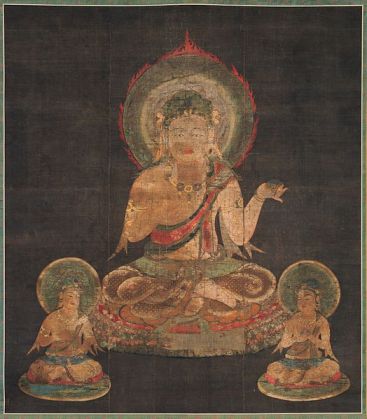
Jiten image from 1127 housed at the Kyoto National Museum. Image from Wikimedia Commons
Prthivi/Jizo: This is a highly altered form of Prithvi. Bodhisattva Jizo is extremely popular all over the Buddhist world, including Japan. The “mother of all creatures” role she plays in the Vedic texts has been amplified into an all encompassing compassion for all beings. According to the mythology, she is currently capable of enlightenment but is waiting to leave the world until all living beings are saved. Her similarity to Avalokiteshvara/Kannon sometimes causes the two to be conflated in Japan. Prthivi worship fell out of fashion relatively quickly in India, so most of Jizo’s evolution took place in China. For more information click here.
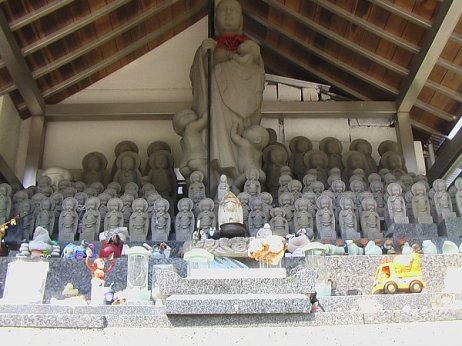
Jizō at Chōsenji Temple (near Beppu City, Ōita Prefecture.) Image from onmarkproductions.com
Varuna/Suiten: A water deity, much like his Indian counterpart though his mount has been switched from a makara to a tortoise (not pictured.) [19] However, in one of his versions he seems to have switched into a female, and taken on characteristics very similar to Saraswati/Benzaiten. Suiten never gained much popularity in Japan, probably because it already had Suijin, a much better established Shinto water deity. [20]
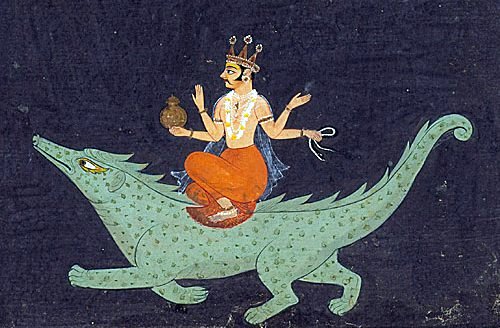
Varuna sitting atop a Makara. Rajastani depiction from 1675-1700. Image from Wikipedia
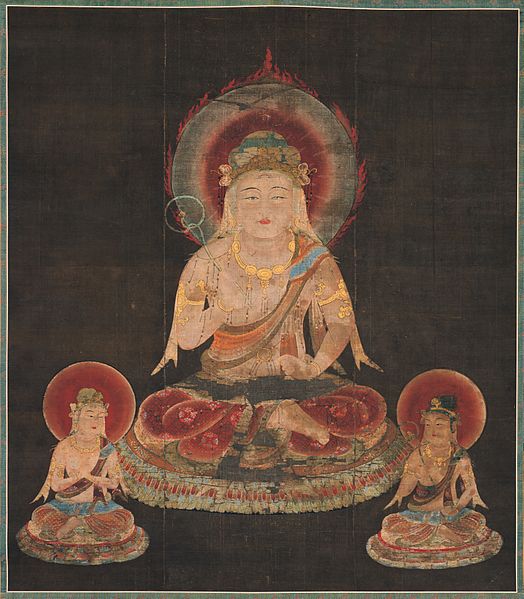
Suiten. Created in 1127. Housed in Kyoto National Museum. Image from Wikimedia Commons
Varuna and Indra/Raijin: Varuna and Indra, along with the Chinese deity Fengshe influenced the development of Raijin, the Japanese God of Thunder. He is depicted with circle of drums swirling around his upper body, which he beats to cause thunder. In Chinese myth him and his ally, Futen were demons who opposed Buddha, but were subjugated by him. Raijin is sometimes credited by the Japanese for causing the powerful storms, which destroyed the invading Mongolian fleet in 1274. [21] [22]
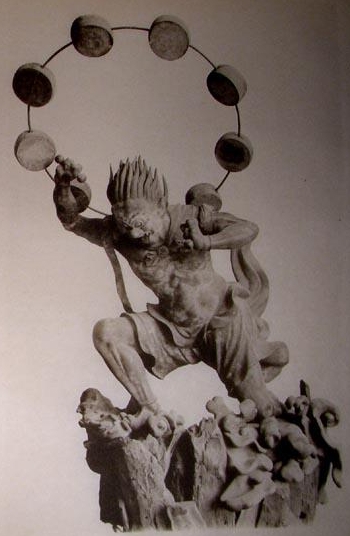
Statue of Raijin from the mid 13th century located in Sanjūsangen-dō (a temple,) in Kyoto, Japan. Image from Wikimedia Commons
Vayu/Futen: Guardian of the northwest. Vedic wind deity blended with the Taoist thunder deity Leigong, the and native Shinto deitiy Fujin. Usually depicted alongside Raijin. [23] His “bag of wind” belies his Shinto roots. [24]
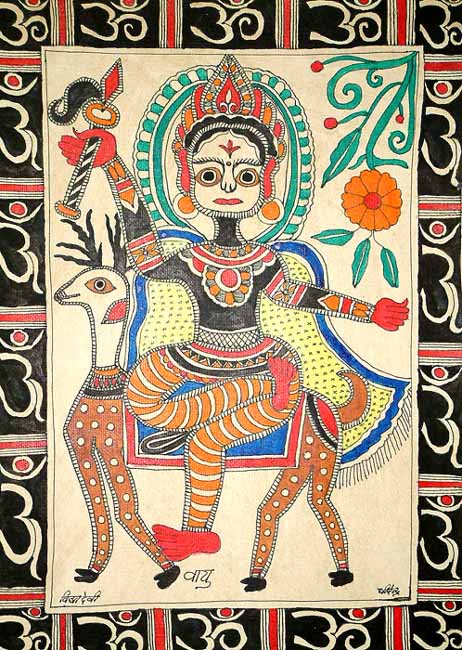
Contemporary Madhubani (Bihari folk art) style depiction of Vayu by the artists Vidya Devi and Dhirendra Jha. Image from Exotic India
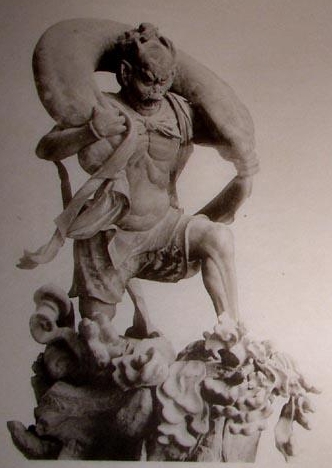
Statue of Fūjin in Sanjūsangen-dō (a temple) in Kyoto, Japan. From the mid 13th century. Image from Wikimedia Commons
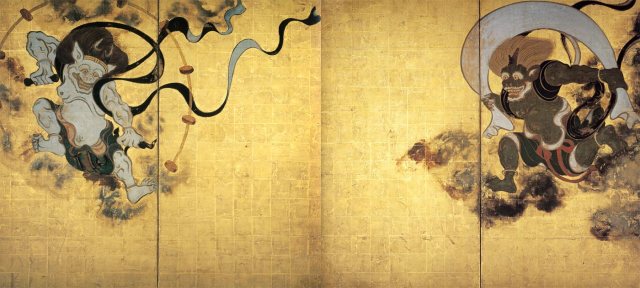
A screen of Raijin (left) and Futen (right) together. By Tawaraya Sotatsu (1600-1640.) Located at Kennin-ji, Kyoto. Image from Gallery Sakura
Skanda/Idaten: Skanda is the Sanskrit name, but in India he is most commonly known as by his Tamil name, Murugan. In both locations he is the son of Shiva/Daijzaiten, and the brother of Ganesha/Kankiten. In an exclusively Japanese myth, Idaten becomes reincarnated as his brother’s wife in order to turn him away from evil. He is therefore often considered to be the female component in the double-Kangiten image. In that case, he is depicted with an elephant head to match Ganesha/Kankiten. [25] Normally depicted balancing a sword and in soldiers garb, he is a protector of Buddha’s teachings. In the Hindu version as well, he is a protective deity presiding over warfare. Like one of his father’s manifestastations (Daikoku-ten) he also serves as a kitchen deity.[26]
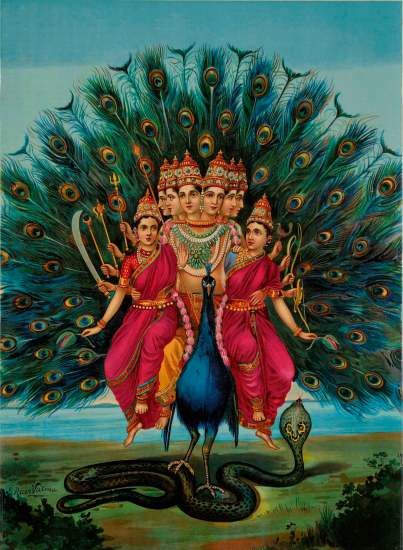
Skanda or Karktikeya or Murugan by Raja Ravi Varma (1848–1906.) Image from Wikipedia
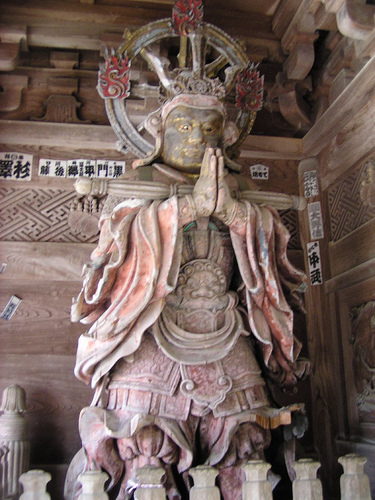
Idaten statue in Zenpou temple. Image from Flickr
An image of Shoten in embrace with his brother Idaten (reincarnated as a female.) Image from Wikimedia Commons
Vishnu/Bichuten: In medieval times, Bichuten was thought to be the divine ruler of China, and the creator of the “Western barbarian script”, in other words the Kharoshthi script used to write Gandhari, the Prakrit dialect spoken in modern northwest Pakistan and Afghanistan. [27]The Kharoshthi script had importance to the Japanese as a language in which many Buddhist texts were written, and translated from. Though Bichuten exists in the Buddhist sutras, images of him are rare or nonexistent. [28]
Vishnu/Ungyo: Ungyo is the closed mouthed “Benevolent King” guardian figure who stands at Japanese temple gates. He stands opposite his open mouthed associate, Vairocana/Agyo (who is a Buddha, not a Deva, and therefore does not appear on this list.) Unlike the calm aspect, which Vishnu normally holds, Ungyo maintains the appearance of a fierce warrior.[29]
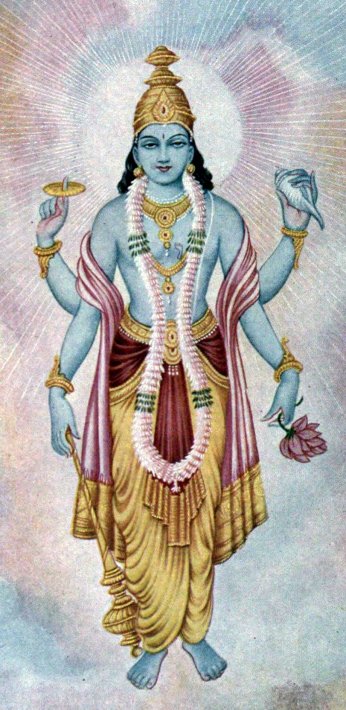
Mid 20th century Vishnu image from an edition of the Mahabharata. Image from Wikipedia
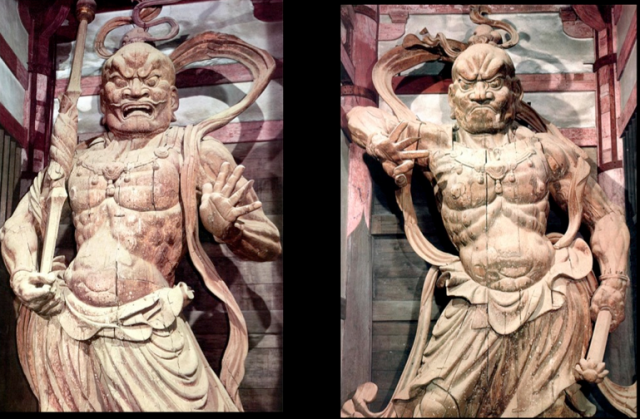
Vairocana /Agno on the left, Vishnu/Ungyo on the right. Image from Studyblue
Lakshmi/Kichijoten: A goddess of fertility, luck, and beauty in both traditions, though she seems much more strongly associated with wealth in the Hindu tradition. Since the 16th century however, Saraswati/Benzaiten has largely supplanted her. In Hindu tradition she is the consort of Vishnu, but in Buddhist tradition her consort is Kubera/Bushamonten.[30]
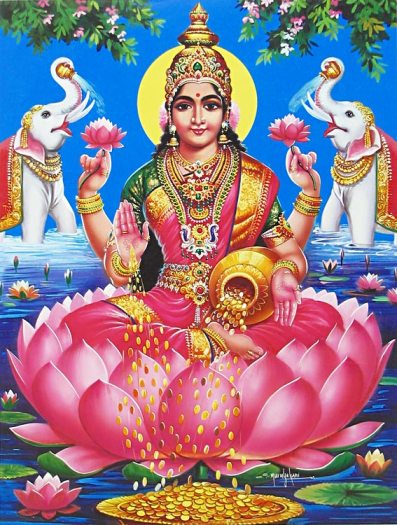
Contemporary printed graphic image of Lakshmi. Image from Dolls of India
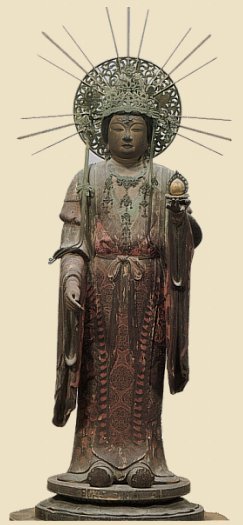
Kichijjōten, 1078 AD, Treasure of Hōryūji Temple (Nara). Image from onmarkproductions.com
(S) Durga/ (S) Chandi/ (J) Juntei Kannon: The Vedic Goddess Durga has a form called Chandi, which is an adaptation of a pre-Vedic goddess of Bengal. This is the form, which was exported to Japan. There, she became one of the six manifestations of Avalokiteshvara/Kannon (the Bodhisattva of compassion) and is associated with human realm of reincarnation. Chandi has undergone other major changes, including usually being depicted as a male, and losing the fierce, warlike aspect she assumed in her Hindu form.[31] [32]
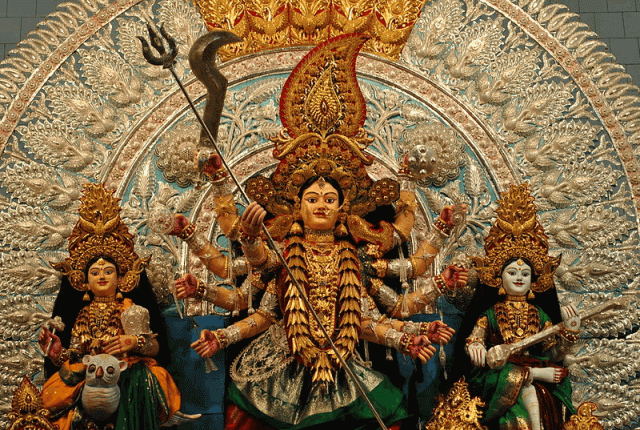
Contemporary Chandi image (center) Chaudhury Bazar, Orissa. Image from Wikimedia Commons
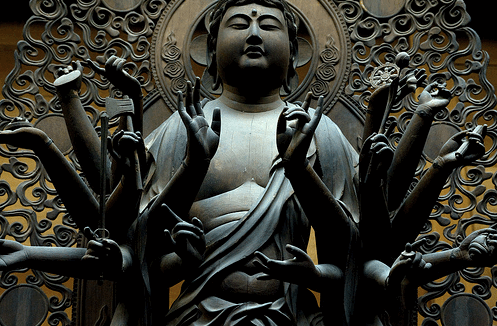
Juntei Kannon, in Daihouon-ji Temple, Kyoto. Image from Flickr
Surya/Nitten: The sun god, or ruler of the sun in Hinduism and Buddhism. Usually depicted alongside Chandra/Gatten, the analogous moon deity.[33]
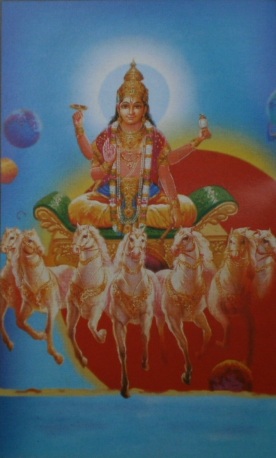
Contemporary printed graphic of Surya. Image from Wikimedia Commons
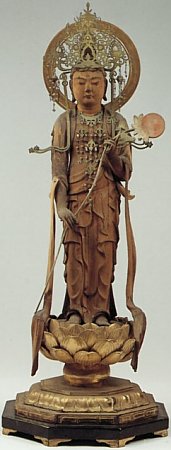
Nitten, 15th-16th Century, Jinmuji Temple (Tendai Sect) Zushi City, Japan. Image from onmarkproductions.com
Chandra/Gatten: The moon god, or ruler of the moon in Hinduism and Buddhism. Usually depicted alongside Surya/Nitten, the analogous sun deity.[34] The gender has switched, so that he is usually depicted as female, and is referred to as “Lady Ruler of the Moon” in the Tendai tradition. [35]
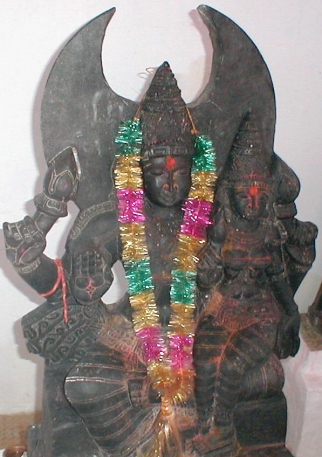
Contemporary Chandra statue, from Surendrapuri temple in Andhra Pradesh. Image from Wikipedia
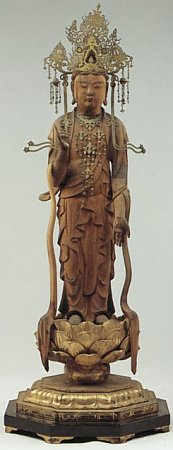
Gatten, 5th-16th Century, Jinmuji Temple (Tendai Sect) in Zushi City. Image from onmarkproductions.com
Vishvakarma/Bishukatsuma: in Hinduism, he is the divine architect of the universe, and the patron deity of architects, builders and craftsmen. However, possibly because Buddhism rejects creator deities, Bishukatsuma’s tendencies towards architecture and large-scale engineering have been altered towards sculpture, carpentry, and arts. [36] [37] [38]
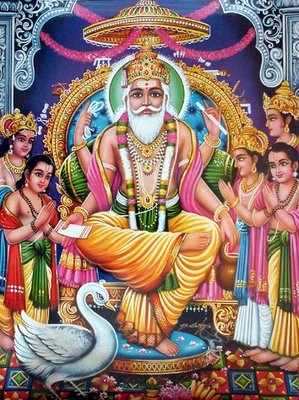
Vishvakarma. Contemporary printed graphic. Image from Wikimedia Commons
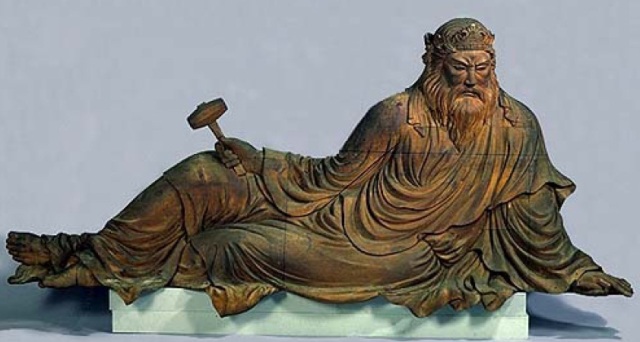
Bishukatsuma statue. Image from the Kyoto National Museum
Agni/Katen: Fire deity who was extremely important in Vedic religion, as messages and offerings to the Gods were carried up through the sacrificial fire. He is important to the Shingon sect because a type of Vedic fire ceremony (called Havan or Homa) has been transmitted and modified by them (into the Goma ceremony). Through Shingon Buddhism Agni veneration also was adopted by the small, mystical sect called Shugendo, though their Goma ceremonies were bonfire sized. [39] [40]
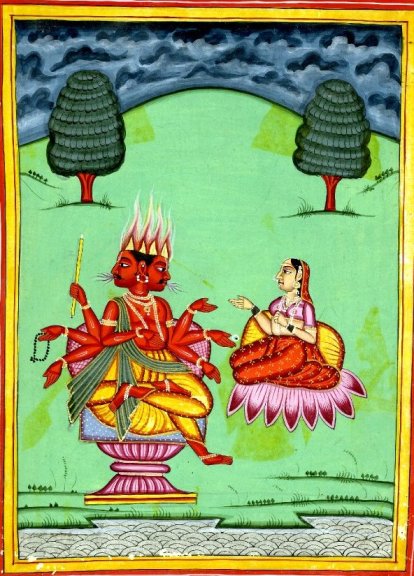
Agni and his consort, Svaha. Circa 1800. Image from Wikimedia Commons
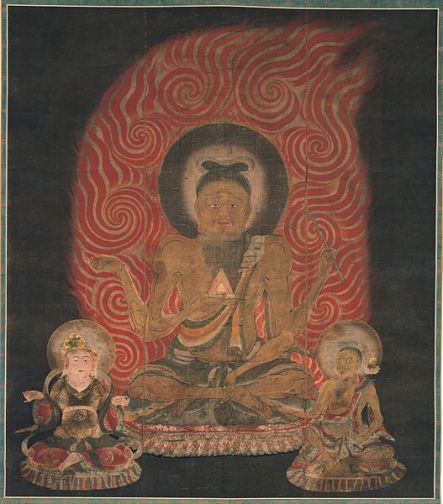
Katen, 1227, located at the Kyoto National Museum. Image from Wikimedia Commons
Hariti/Kishimojin: While not strictly a Hindu Deva, she was an Iranic Daeva, so I’m including her on this list. In my previous post I detailed a Buddhist myth in which she is a child eating yaksha who turned into a benevolent child guarding entity after meeting the Buddha. That still basically applies. Her depictions follow much closer to a goddess or a bodhisattva than a yaksha though. She symbolizes fertility, easy childbirth, and the protection of children. She is usually depicted with only one child, whereas in Indian iconography she is often crawling with children.[41]
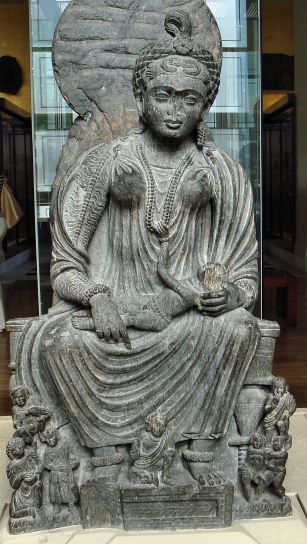
Hariti, 2-3rd century, from Gandhara. located in British Museum. Image from Wikipedia
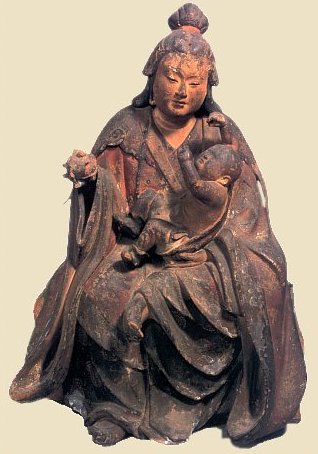
Kariteimo, Early 13th Century,Treasure of Onjōji Temple in Shiga Prefecture. Image from onmarkproductions.com
Hayagriva/Ba-to Kannon: Hayagriva, the horse headed incarnation of Vishnu exists in the Japanese Shingon school, but not as his own figure. He is one of the six manifestations of Avalokiteshvara/Kannon (the Bodhisattva of infinite compassion) and is associated with the animal realm of reincarnation. In Japanese depictions rather than having an actual horse’s head, he either wears a horse-head crown atop his normal human head, or rides a horse. The Buddhist version of Hayagriva is much more fierce than the Hindu version. in Japan he is called a “funnu” or angry deity known for destroying demons. The Hindu variant is purely a God of wisdom and knowledge. [42] Probably because of a pre-existing Shinto horse cult which was associated with the protection of roadways, Ba-to Kannon is also a road-protecting deity. Livestock owners also pray to him for the protection of horses and cattle. [43]
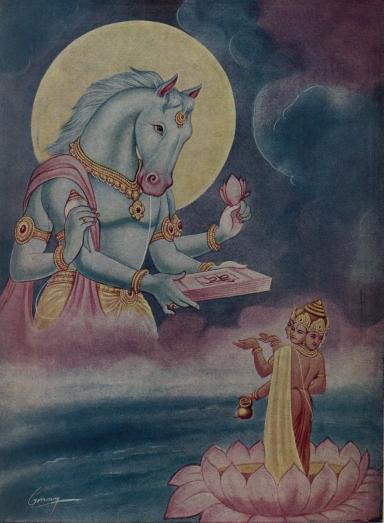
Mid 20th century Hayagriva image from an edition of the Mahabharata. Image from Wikipedia
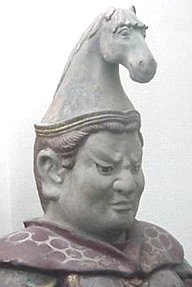
Ba-to Kannon, Kamakura, 1449-1471. Image from onmarkproductions.com
Acalanatha/Fudo: He is the Center deity of the Five Buddhas of Wisdom (another system of cardinal direction guardians.) He is very prominent in Shingon buddhism and is known for his incredibly fierce appearance and associations. His sword is for cutting through ignorance, and subduing non-believers and demons (often surrogates for desires or temptations in Buddhism.) His terrifying appearance is meant to scare people into accepting the Buddha’s teachings, and relatedly, he is a figure associated with religious instruction. [44] He also carries a rope, and has a third eye. In Shingon Buddhism he presides over the post-funeral memorial service. [45]
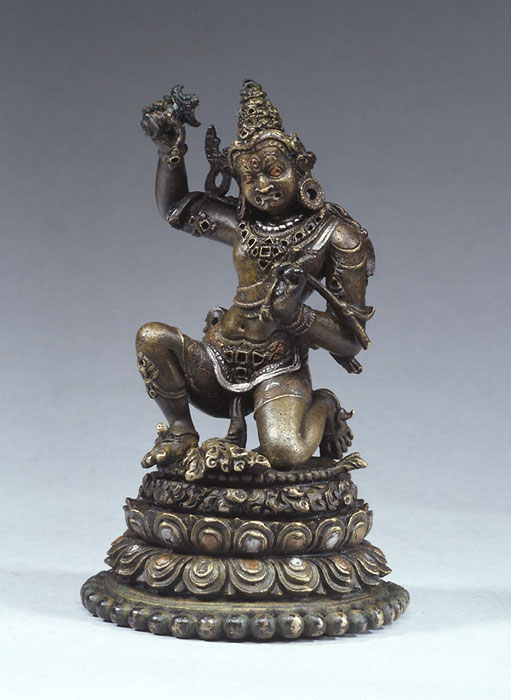
Acalanatha (Acala) Eastern India, 11th– 12th century. Image from Cast for Eternity at asianart.com
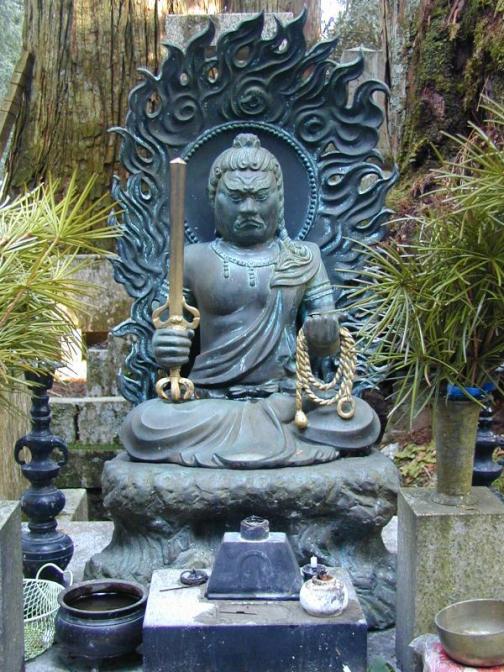
Fudo statue at Mt. Foya (Okunoin, Koya, Japan) Image from Wikipedia.
I’ve made this list as extensive as possible, but there are plenty of other Devas who are mentioned in the Buddhist sutras who probably have depictions. I know for a fact that Uma, and Indrani have Japanese counterparts. There are several other versions of Vishnu, which I couldn’t cover. I know of one depiction of Krishna, though I doubt he was worshipped. There are also figures like Marichi and Yamantaka, which I left out for reasons of their own. I also know that the rest of the Heavenly Kings, Bodhisattvas, Vidyadharas, yakshas, rakshasas, kumbhandas, nagas, makaras, ghandharvas and apsaras were also adopted into Japanese culture and mythology, but if I detailed all of them then this post would become even more completely unwieldy than it already is. If you really must investigate further, this website was incredibly useful to me: http://www.onmarkproductions.com/html/buddhism.shtml Seriously I owe a major debt of gratitude to that website for all the information and images they provided me. And by they I mean Mark Schumacher and whatever associates he may have I seriously love those guys.
I only cited these slides in an image credit, but if you are interested in this stuff, its a good resource: http://huntingtonarchive.osu.edu/resources/lectures/670/lect22.pdf
[1] Krishan, Y. Gaṇeśa: Unrevelling an Enigma. Delhi: Motilal Banarsidass, 1999. Pages 164-165. Google Book: http://tinyurl.com/agktw2u
[2] Brown, Robert L. Ganesh: Studies of an Asian God. Albany: State University of New York, 1991. Pages 69-79. Google Book: http://tinyurl.com/ae5b9ec
[3] Ibid 1, pages 167-169
[4] Suzuki, Teitaro. The Seven Gods of Bliss. Chicago: The Open Court Publishing Company, Open Court vol. xx1, published 1907. Converted to HTML in 2002 by Christopher M. Weimer: http://www.sacred-texts.com/journals/oc/ts-sgb.htm
[5] Schumacher, Mark. Japanese Buddhist Statuary: http://www.onmarkproductions.com/html/daikoku.shtml
[6] Teeuwen, Mark. Rambelli, Fabio. Buddhas and Kami in Japan: Honji Suijaku as a combinatory paradigm. New York: RoutledgeCurzon, 2003. Heading title: “The Three Brothers: Creators of Different Writing Systems.” Google Book: http://tinyurl.com/ac65a4s
[7] Schumacher, Mark. Japanese Buddhist Statuary: http://www.onmarkproductions.com/html/daikoku.shtml#sanmen
[8] Ashkenazi, Michael. Handbook of Japanese Mythology. Santa Barbara, CA: ABC-CLIO, 2003. Page 126. Google Book: http://tinyurl.com/bkmzmlp
[9] Schumacher, Mark. Japanese Buddhist Statuary: http://www.onmarkproductions.com/html/benzaiten.shtml#.UQwQQErBNbx
[10] Schumacher, Mark. Japanese Buddhist Statuary: http://www.onmarkproductions.com/html/bishamonten.shtml
[11] Illes, Judika. The Encyclopedia of Spirits: The Ultimate Guide to the Magic of Fairies, Genies, Demons, Ghosts, Gods, and Goddesses. New York: HarperOne, 2009. Page 281. Google Book: http://tinyurl.com/az2ufwx
[12] Schumacher, Mark. Japanese Buddhist Statuary: http://www.onmarkproductions.com/html/taishakuten.html
[13] Chaudhuri, Saroj Kumar. Hindu Gods and Goddesses in Japan. New Delhi: Vedams E (P), 2003. Page 93. Google Book: http://tinyurl.com/ajebmm9
[14] Doug, A fellow wordpress blogger! Enma: Lord of Hell http://jkllr.net/2009/06/01/enma-lord-of-hell/
[15] Schumacher, Mark. Japanese Buddhist Statuary: http://www.onmarkproductions.com/html/karura.shtml
[16] Thakur, Upendra. India and Japan, a Study in Interaction during 5th Cent.-14th Cent. A.D. New Delhi: Abhinav Publications, 1992. Page 40. Google Book: http://tinyurl.com/aqzloy7
[17] Ibid 6, Heading title: “The Third Link: From Tenjin to Mahevra)
[18] Ibid 6.
[19] Ibid 13, Page 125
[20] Schumacher, Mark. Japanese Buddhist Statuary: http://www.onmarkproductions.com/html/suijin.html
[21] Schumacher, Mark. Japanese Buddhist Statuary: http://www.onmarkproductions.com/html/28-bushu-kannon.shtml#wind-thunder
[22] Neely, Wayne. The Great Bahamian Hurricanes of 1889 and 1932. Bloomington: iUinverse, 2012. Pages 23-24. Google Book: http://tinyurl.com/arz6syh
[23] ibid 13.
[24] Roberts, Jeremy. Japanese Mythology A to Z. New York, NY: Chelsea House, 2010. Page 41. Google Book: http://tinyurl.com/at4527z
[25] Ibid 1.
[26] Schumacher, Mark. Japanese Buddhist Statuary: http://www.onmarkproductions.com/html/kankiten-idaten-other-tenbu.html#idaten
[27] Ibid 6.
[28] Strauch, Ingo. The Bajaur collection: A new collection of Kharoṣṭhī manuscripts – A preliminary catalogue and survey – . 2008: http://www.geschkult.fu-berlin.de/e/indologie/bajaur/publication/strauch_2008_1_1.pdf
[29] Schumacher, Mark. Japanese Buddhist Statuary: http://www.onmarkproductions.com/html/nio.shtml
[30] Schumacher, Mark. Japanese Buddhist Statuary: http://www.onmarkproductions.com/html/kichijouten.html
[31] Schumacher, Mark. Japanese Buddhist Statuary: http://www.onmarkproductions.com/html/kannon.shtml#juntei
[32] Leighton, Taigen Daniel. Faces of Compassion: Classic Bodhisattva Archetypes and Their Modern Expression–an Introduction to Mahayana Buddhism. Boston: Wisdom Publications, 2012. Page 176. Google Book: http://tinyurl.com/acaoezj
[33] Schumacher, Mark. Japanese Buddhist Statuary: http://www.onmarkproductions.com/html/nikko-gakko.shtml
[34] Schumacher, Mark. Japanese Buddhist Statuary: http://www.onmarkproductions.com/html/nikko-gakko.shtml
[35] Saso, Michael R. Tantric Art and Meditation: The Tendai Tradition. Honolulu: Tendai Educational Foundation, 1990. Page 29. Google Book: http://tinyurl.com/b3gxy57
[36] The Soka Gakkai Dictionary of Buddhism, Entry on “Vishvakarman:” http://www.sgilibrary.org/search_dict.php?id=2611
[37] National Diet Library, Imperial Household Museum of Kyoto — Western-style Building from the Meiji Era –– http://www.ndl.go.jp/scenery/kansai/e/column/imperial_household_museum_of_kyoto.html
[38] Agarwal, M.K. From Bharata to India. Bloomington: iUinverse, 2012. Page 389. Google Book: http://tinyurl.com/ay9o5xq
[39] Schumacher, Mark. Japanese Buddhist Statuary: http://www.onmarkproductions.com/html/12-devas.shtml#katen
[40] Shugendo, Doctrines Costumes and Tools symbolisme: http://www.shugendo.fr/en/doctrines-costumes-and-tools-symbolisme
[41] Schumacher, Mark. Japanese Buddhist Statuary: http://www.onmarkproductions.com/html/kariteimo.html
[42] Schumacher, Mark. Japanese Buddhist Statuary: http://www.onmarkproductions.com/html/kannon.shtml#batou
[43] Brill, E.J. Hayagrīva: The Mantrayānic Aspect of Horse-cult in China and Japan. Holland. Page 80. Google Book:http://tinyurl.com/akrzn63
[44] Bowring, Richard John. The Religious Traditions of Japan, 500-1600. Cambridge, UK: Cambridge UP, 2005. Pages 282-284. Google Book: http://tinyurl.com/apced9o
[45] Schumacher, Mark. Japanese Buddhist Statuary: http://www.onmarkproductions.com/html/fudo.html
Excellent presentation – both in depth and scope. Warm Regards
I’m glad you enjoyed it! Initially I initially expected to only survey a few deities, but as I got deeper into the research I discovered how expansive the subject is, and curiosity compelled me to keep going.
Dear fellow Hindu , it is a flabbergasting experience reading this well curated article.
Korean language has some Indian words as well.
When I was visiting Munich , in the hotel breakfast dining room I overheard a Korean boy calling his dad APPA.
Thanks for the kind words.
Thanks for this post. I was just penning one down on the same subject for my blog !. Perhaps you’d consider sharing your post on All About Hinduism ?
Hello Anu,
I’d love for you to share my post on All About Hinduism! If you need any information or assistance from me in order to do this, feel free to contact me at videshisutra@gmail.com and I’ll help in any way possible. Great job on All About Hinduism by the way, it seems really successful. =)
Thanks for commenting
Dear Videshi,
Sorry there seems to have been a wordpress glitch and I was not notified of any response from you, so assumed there was none. Glad I checked it out now.
Not sure if my blog’s all that successful but I am quite enjoying it and the good thing is, there won’t be a shortage of topics anytime soon 🙂
Well I am going to reblog this on my site after I finish part 2 of my present post on Ganesha.
Meanwhile my friend who owns a very very successful blog on Shinto, http://www.greenshinto.com
had an interesting question for me. How did the Hindu gods end up in Japan as Buddhist deities and not Shinto kami since they are closer in spirit to the latter?
I said that was probably because they came there as Buddhist deities via China and Malay.
But that sent me on a research trail of my own to find the first evidence of Hindu gods and goddesses being adopted in Hinduism by the Buddhist and Jain sects. I haven’t been able to come up with much.
Can you shed some light on the same?
Will let you know once I have re-blogged your post.
Thanks a ton and keep writing
Anu
Hello Anu,
What an excellent Shinto blog you linked to! Lots to go through there. The author seems incredibly knowledgable.
But to answer some of your points: The fact that Devas were adopted at all in Japan probably owes to their conceptual similarity to Kami. Buddhism in other places like Central Asia didn’t place nearly so much emphasis on the Devas. The other major factor is the presence of the esoteric Shingon sect of Buddhism, which placed a big emphasis on Devas. Esoteric sects typically brought a lot more from the Vedic tradition than more mainstream sects. Shingon also uses Sanskrit based Siddham script, and has a Goma (Homa) (Havan) fire ritual.
The only correction I’d make is that Buddhism came to Japan via China, and as Chinese Buddhism is by and large Mahayana, it was transferred *mostly* via Central Asia, Afghanistan, and India, not from Theravadin Southeast Asia.
I’d say the reason the Devas and Kami never merged, is because, as you say, Devas are embedded firmly in Buddhist cosmology. So as long as Buddhist and Shinto theology remain distinct (and they were more distinct in the past than they currently are,) the conceptual categories of Kami and Deva will remain distinct. That said, I do think that absent bigotry and government intervention, a lot more syncretism would have taken place.
From time to time there has also been anti-Buddhist sentiment in Japan, which, enabled by government policies such as Shinbutsu burn: http://en.wikipedia.org/wiki/Shinbutsu_bunri has forcibly kept the two from amalgamating. See also: http://en.wikipedia.org/wiki/Shinbutsu_kakuri
However, the existence of these trends implies that they were reacting against something. There has in fact been a large degree of syncretism between Kami and Devas. For example:
Saraswati/Benzaiten has been adopted as a Kami: http://www.onmarkproductions.com/html/benzaiten.shtml#.UYrtKStoRby
Varuna/Suiten is an amalgam of a Devi and a Kami: http://www.onmarkproductions.com/html/suijin.html
(You can find a bunch more examples of it on that website)
See also: http://en.wikipedia.org/wiki/Shinbutsu_sh%C5%ABg%C5%8D
That was kind of a disorganized reply, but I hope you found it interesting or helpful
All the best
-Videshi
Hi Videshi, Thanks a lot for your reply. I couldn’t find a way to reply on your post in the same thread hence emailing you. No it wasn’t a disorganised response . It makes sense. I can see now why devas continue to exist there in the forms that they do. I have re-blogged your post on my site. And look forward to wandering through the rest of your blog as and when I have the time. Great stuff! ThanksAnu
Date: Thu, 9 May 2013 00:49:21 +0000 To: anuradha1@hotmail.co.uk
I love this post. I have a post of my own dealing in the same subject, which I am also fascinated by, but I couldn’t go nearly as in-depth as you clearly have. This post is worthy of praise! As are you, the blogger who wrote it.
Oh, I forgot to provide the link to my post, should you wish to see it.
Hello defenderofmyself,
I appreciate your kind words. I checked out your post on this shared interest of ours. You certainly hit on the major points, and also discuss some things which I couldn’t, because of the limited scope of my post. I particularly enjoyed as the bit about the “Komainu” guardian lion-dogs. I didn’t know about them! I’d encourage any of my readers to click above and check out defenderofmyself’s post on this subject.
Thanks
-Videshi Sutra
Yeah well, I didn’t intend on focusing on just gods, like you have (awesomely), but as many facets of the role of Hinduism in Japanese religion. The Komainu are an example of deep Indian symbolism in Japanese iconography. I like how you referenced onmarkproductions.com. I like that site. It’s ironic that Hinduism has a small following in Japan despite it’s huge role in shaping Japanese culture.
Reblogged this on My Thoughts Born from Fire and commented:
I already have a post of my own about Hinduism and Buddhism in Japan (a subject that fascinates me), but this blogger has done in more depth than I. Here’s a token of appreciation for Videshi Sutra for this magnificent post.
[…] To find out more on how the Buddhist versions of Hindu gods were integrated into Japanese culture ( with fantastic images) read the rest of the article Hindu Devas Take a ( Silk Road) Trip to Japan! […]
Thanks
Very interesting
[…] […]
[…] all of them involve some sort of gender reversal, usually by means of reincarnation.[1] There is a huge corpus of Japanese Ganesha myths, which do not exist at all in India, but the […]
[…] all of them involve some sort of gender reversal, usually by means of reincarnation.[1] There is a huge corpus of Japanese Ganesha myths, which do not exist at all in India, but the […]
Reblogged this on Integral Yoga of Sri Aurobindo & The Mother and commented:
Fascinating and well-documented article on the iconic deities of Hinduism like Ganesha, Shiva, Brahma, Lakshmi, Durga, Saraswati, Kubera, Indra and others who have been depicted in ancient Japanese literature and paintings.
Thanks for the reblog! Glad you enjoyed the piece Sandeep.
Thank you for this post of the deities. It eases my search to exercise discriminating awareness of archetypal forms.
Im glad the article was able to help in your search!
Very interesting. Just one observation, the function/figures associated with Ungyo/Agyi seem to be more like Jaya & Vijaya, the dwarapalakas of Vishnu’s abode, Vaikuntha.
It is an interesting observation. Who knows how these stories interacted and became altered during the transmission process?
[…] If you enjoyed this article, you might also enjoy something else I wrote on Indian painting, misleadingly titled “King Akbar’s Mahabharata, or the Razmnama (Book of Wars)” or a different art history essay on the transmission of Hindu and Buddhist deities to Japan entitled “Hindu Devas take a (silk) road trip to Japan!“ […]
[…] already made a post about Hindu iconography in Japan, as expressed primarily in Shingon Buddhism. Now I’ll look to the west. As in the east, Hindu iconography appears in an ancient and […]